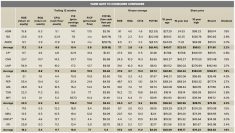There are a lot of changes underway that will have significant impacts on the future of our grain buying and ag retail business. This is my second column on the Canadian grain scene.
Viterra/Glencore
We know the history behind Viterra/Glencore’s evolution from the days of the Prairie Pools to today’s corporate entity known as Viterra. Manitoba and Alberta Pools formed Agricore, then United Grain Growers joined and the name was changed to Agricore United. Then the Saskatchewan Wheat Pool joined to create Viterra.
Read Also

Managing through market or individual stock declines
Even the best of public-traded companies can periodically experience significant drawdowns, and a successful investor should be prepared to react — or not react — accordingly, Herman VanGenderen writes.
In 2012, Glencore, a Swiss-based world-leading commodity trading and mining company, along with Agrium and Richardson’s International acquired 100 per cent of Viterra’s shares. They split up the assets of the company with the majority of the retail ag facilities going to Agrium and some strategic grain handling facilities, ag retail locations and processing facilities going to Richardson International (Pioneer).
When the acquisition took place, farmers I talked to had concerns. Not so much about the change of ownership of the company, as about the sale of the majority of ag retail outlets to Agrium. Farmers saw this as the elimination of a competitor, giving Agrium dominance in an ever-shrinking retail marketplace across the Prairie provinces.
Over the past 12 months, the world economic downturn has hurt Glencore. Its share values have fallen over 70 per cent. Glencore recently announced a range of cost-cutting measures, including selling some assets and suspending production at copper mines in Zambia and the Democratic Republic of Congo. It has axed the full-year dividend payout to shareholders, due in 2016, as well as next year’s interim dividend. This series of measures is expected to find the company an extra $10.2 billion, which will be used to pay down some of its current $30 billion debt.
Those assets they are looking at selling off are some or all of its ag related assets, which of course includes Viterra.
All of a sudden some grain handling facilities and/or port facilities in Canada may be coming up for sale. This no doubt may pique the interest of a few different competitors in the grain business here in Canada and abroad.
As mentioned in my previous article the one thing G3 (the former CWB) is lacking is a West Coast port facility. Once the company solves that problem it would no doubt expand its grain buying presence into the Alberta/B.C. Peace region to supply a West Coast facility or two.
So now we have Viterra, whole or in part, possibly up for sale with West Coast port facilities and a network of country grain terminals across the Prairies that would fit very nicely into G3’s business growth strategy.
Let’s see how this scenario plays out over the next few months.
Richardson Pioneer
Richardson International Ltd. or JRI or Pioneer are all part of the same Company .
It is a privately held Canadian agricultural and food industry company that was started in 1857 and is headquartered in Winnipeg.
Over the past number of years Richarsdon has been continually expanding its presence in the grain, processing and Ag retail sectors across Canada and beyond.
In March 2012 in the Glencore/Agrium/Richardson International takeover of Viterra, Richardson acquired 19 grain elevators, the oat and wheat milling business in Canada and the U.S., a terminal in Thunder Bay and a share of Cascadia terminal in Vancouver.
From 2013 to 2015, a number of expansions and upgrades took place at grain and crop input centres. A new terminal was opened in Estevan, Sask., and expansion plans to add 80,000 mt of storage at the Vancouver terminal were done. They also started work on a new terminal in Dauphin, Man. to be completed in 2016.
Richardson recently completed a new fertilizer distribution center at Carseland, Alta., its sixth fertilizer distribution warehouse in Western Canada.
Richardson recently announced plans to build a new fertilizer blending facility at its Olds, Alta., facility and a new crop inputs center at Three Hills, Alta.
Needless to say, Richardson International is serious about being a major player in the grain and ag retail business in Western Canada as is evident by their activities over the past few years. Keep an eye on this company.
CHS
CHS is the largest ag co-op in the U.S. It has business interests in countries around the world (learn more about it at www.chsinc.com.)
In 2012 CHS bought out DynAgra Corp., an ag retail business with four locations in Alberta. This is CHS’s first Canadian acquisition.
In August of 2015, CHS and fertilizer maker CF announced a strategic business venture where CHS will invest $2.8 billion into CF Nitrogen and enter into a supply agreement giving CHS access to up to 1.7 mt of nitrogen fertilizer annually from any of CF’s three nitrogen facilities in the U.S. This transaction is the largest investment in CHS history.
The news that Glencore may be selling all or part of Viterra brought comments from CHS Chief Executive Carl Casale that CHS Inc. would be interested in the Canadian grain handling assets, but only if they came at the right price. Another potential suitor looking to get into the Canadian grain industry?
The most recent announcement was October 14 when CHS and UFA announced a joint venture under the name of Bridgeland with plans to build a fertilizer and ag retail outlet in the northern peace region near Sexsmith Alta.
Canada’s grain and ag retail industry is continually in flux. Ag retail is a capital intensive industry with tight margins. Unless you have production capacity to help build your margins you are in a game of very small returns for the dollars invested.
The grain industry is not a lot different. Large amounts of capital are required to build facilities to move grain to market or process grain, but there seems to be some potential for profits — especially for companies that are integrated in the business already with processing or freight and transportation expertise.
Is it a coincidence that we are seeing more first time foreign entities enter this marketplace since the demise of the wheat monopoly in 2012, opening the market up to anyone willing to take on the risk?
It may be as simple as the ability to access high quality guaranteed products from a reliable supplier from a safe part of the world where minimal disruptions would affect business or profitability.
Whatever the business rational, be assured that there will be more such transactions like these in the future.
The future of the industry
The world needs food and Canada can certainly grow it. We can’t consume all we grow so there is a great business opportunity there for those who have the knowledge and capital to do so.
Trade deals are another piece of the puzzle. They help reduce barriers and tariffs to allow for freer trade between countries, which opens up new markets providing new opportunities for companies to transact business around the world.
The Canadian grain industry is in the midst of transformative change. You need to be aware and stay engaged to ensure your interests are looked after as these changes happen.
















